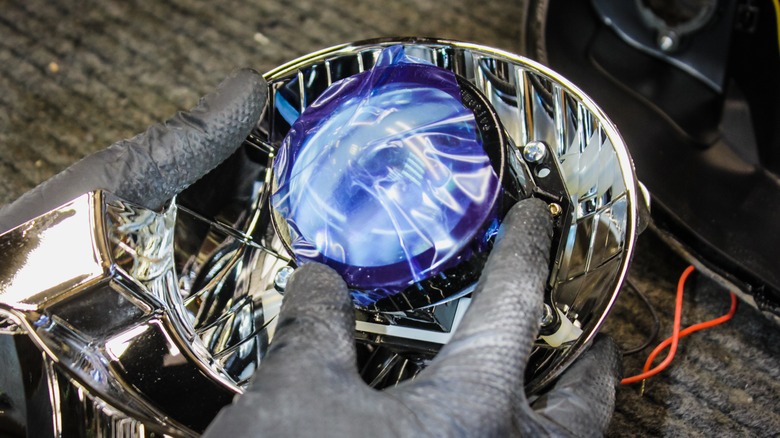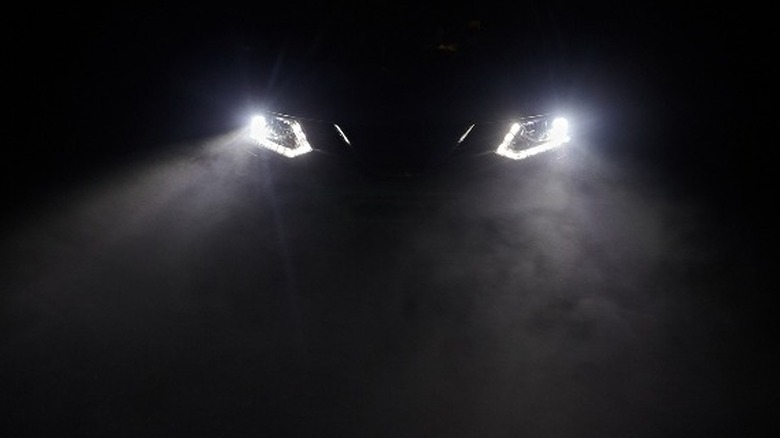The Real Reason Why Headlights Seem To Be Getting Brighter
Headlights are a basic safety feature included on every modern roadworthy vehicle, and the reason why seems obvious: light is a necessity, especially for driving in unfavorable weather or at night. So, if everyone needs light to use their cars safely at night, surely more light is better? Well, not necessarily. According to a National Highway Traffic Safety Administration (NHTSA) report, 31% of survey respondents said that nighttime glare from oncoming headlights was "disturbing," while another 57% said that the glare was noticeable but that they considered it acceptable.
Lamp designs have changed a lot since the early days of the sealed-beam lights that first appeared in the 1950s, with Consumer Reports noting that it found LEDs in 86% of the 2019 model year vehicles it tested. Though LEDs are the newest kid on the block, high-intensity-discharge (HID) headlights have been around since the 1980s, and Consumer Reports also found that HID lights often performed the same or better than LEDs when it came to adequately illuminating the road ahead.
So why, then, do modern headlights — particularly those that use LEDs — seem so much brighter than the headlights used in previous decades? It seems to come down to a combination of factors, including vehicle types, headlight design, and even how the human eye and brain perceive and process light.
The effects of vehicle trends and safety ratings
For starters, as Cars.com reports, LED lights tend to cast a wider beam of light than their halogen and HID counterparts, making it easier to blind oncoming traffic because the light more easily reaches eye level. Logically, lighting position and vehicle design can also drastically change the way headlights affect other drivers. According to the International Energy Agency, the annual SUV sales market share has increased from 16.5% in 2010 to 45.9% in 2021, meaning there are more SUVs on the road than any other single vehicle type. The increase in SUV adoption means there are more vehicles around that have lights mounted higher up, casting a higher beam and blinding the drivers of smaller cars they pass on the road as a result.
Perhaps a more interesting discussion is pressure from safety rating agencies like the Insurance Institute for Highway Safety (IIHS), which has been pushing vehicle manufacturers to include better headlights on their vehicles for years. The IIHS sets the bar for "good" low-beam headlights at 325 feet of illumination ahead of the vehicle, as it takes around that long for a person to spot an upcoming obstacle in the road and stop a car traveling at 60 miles per hour.
According to the IIHS, 2020 was the first time all of the vehicles it tested came with an option for headlights that achieved a "good" rating. In order to so do, headlights need to either be brighter or aimed higher to illuminate the road farther ahead, meaning they're more likely to bother oncoming traffic. Though the IIHS factors in the momentary glare from oncoming traffic when rating headlights, there's clearly some sort of disconnect, as the number of complaints from drivers is increasing.
Headlights are getting brighter, wider, and... smaller?
Human perception may also be partially to blame for the increase in perceived glare from oncoming traffic. The switch from sealed-beam and halogen bulbs — which use a reflector to spread the light outward from the bulb — to projection-based technologies that don't use a reflector makes headlights seem brighter even if they aren't. This technology allows automakers to put smaller headlight designs on cars, which makes them look more stylish but may come with the consequence of producing light beams that disturb a greater number of drivers.
Participants in a 2005 study published in the "Journal of Passenger Car: Mechanical Systems Journal" consistently reported that LED lights were brighter than halogen lights of equal intensity. The same study speculates that the reason for this difference in perceived brightness is that halogen lamps have a larger emission surface thanks to the reflector used to project the light, while LED headlights have one or multiple small light sources. Emitting light from a small source rather than a larger reflector makes the light seem brighter because the brain perceives brightness by comparing it to what's around the light source.
The dark spaces immediately next to small, bright light sources make those light sources seem much brighter than they are because of the intense contrast. Unfortunately, laws are slow to adapt to the technical changes, but hopefully, the 2023 rollout of the Infrastructure Investment and Jobs Act will hasten U.S. adoption of adaptive systems like Audi's Digital Matrix so that the issue can finally be addressed.


